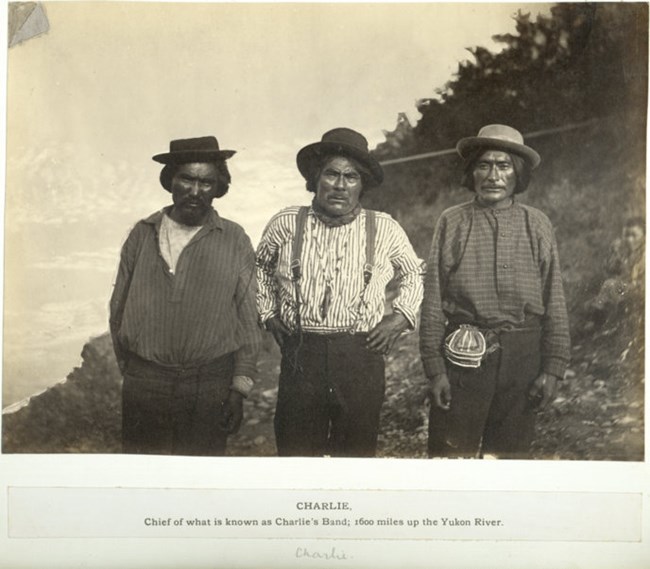
Charles Farciot To discuss Charley's Village one must first acknowledge the village's namesake. Chief Charley was the leader of a group of Han Gwich'in Athabaskans living along the Yukon River sometime during the late 19th and early 20th centuries. The first known appearance of Charley in the written record is found in the 1871 journals of Robert McDonald, an Anglican Missionary. Robert and his brother Kenneth, also a missionary, document their various interactions with Charley and his people throughout the upper Yukon country until 1876. In 1879 the persistant trader Leroy "Jack" McQuesten stopped at Charley's Village on his way upriver to attempt to reopen the defunct Hudson's Bay Company's Fort Reliance. McQuesten declined Charley's offers to set up a trading post at the village as he did not want to build a new store. The following summer explorer Ivan Petrov stopped at Charley's Village and noted the presence of 48 inhabitants. This is the first mention of the size of Charley's band. The first description of the actual village comes from Lt. Frederick Schwatka, who in 1883 noted a village at the mouth of the Kandik River which was composed of 5 or 6 small houses and populated by approximately 50 people. Another account of the village comes from a prospector enroute to the Fortymile country in 1886. As Arthur Walden describes it, the village consisted of "three or four houses, built of tiny poles laid one on top of the other." By the late 1880's a gold rush was in full swing and it seems that Charley and his band abandoned their village by the Kandik to relocate to the Fortymile country, perhaps to be closer to imported goods and the opportunity for increased trade. Apparently by 1900 Charley's Village was once again inhabited according to the accounts of Judge James Wickersham who briefly describes visiting Charley's Village in February of 1901. A U.S. census taker in 1910 recorded the population of Charley's Village at 25 people. In June of the following year Hudson Stuck visited the village and counted 10 to 12 people. He counted only 7 the following April. Two years later during the spring breakup of 1914 Charley's Village finally met its end, swept away by flood waters. Though many accounts noted the location of the village over the years, some of them were conflicting and as there were very few reliable maps created at the time which documented such features as Native villages, the precise location was to remain somewhat of a mystery for many years. In 1974, during preliminary surveys conducted in order to assess the environment and culture history of the then proposed Yukon-Charley Rivers National Preserve, a crew led by Edwin Hall Jr. attempted to locate the village site but to no avail. Three years later, based on oral histories and various documented accounts, historian, Melody Webb visited what she believed to be the site of Charley's Village, but did not conduct a thorough survey or make any collections. It was not until 1992 that any intensive effort was undertaken to assess if the site documented by Webb, might in fact be Charley's Village. That summer a crew of NPS archaeologists noted artifacts on the beach and eroding out of a cutbank near where Webb has postulated the village may have been. They surveyed the site, made maps, took photos, and collected a series of artifacts. Based on these efforts they were convinced they had found the remnants of the historic Charley's Village. A discussion of the crew's findings was presented by Richard Bland, one of the archaeologists, at a small anthropology conference the following year. This was then filed in an internal NPS report, which was briefly added to after a second site visit by a different NPS team of archaeologists in 2000. However, it was not until the 2004 publication of Han; People of the River wherein a more thorough ethnohistoric accounting of Chief Charley, his people, and his village is described, is there any in depth public documention of the subject. The Yukon flooded again in the spring of 2009. The following summer an NPS archaeological crew once again revisted the Charley's Village site to conduct a site condition assessment. They found that the site is actively eroding and noted that in fact very little may be left to study. Due to recurring floods and the rigors of time, the existing Charley's Village museum collections and documented accounts may be all that we have left to study. Without the continued efforts of NPS staff to document, preserve, and protect cultural resources, this important site, and more importantly the local heritage it represents, may well have been lost. Suggested Reading: Han; People of the River, Craig Mishler and W. E. Simeone (2004) The Han Indians: A Compilation of Ethnographic and Historical Data on the Alaska-Yukon Boundary Area, Cornelius Osgood (1971) The Last Frontier: A History of the Yukon Basin of Canada and Alaska, Melody Webb (1985) |
Last updated: July 29, 2020
